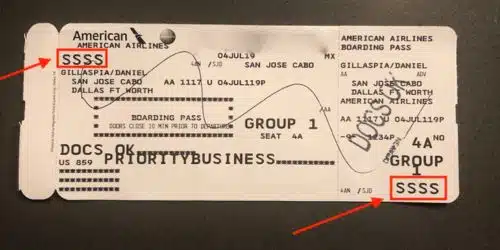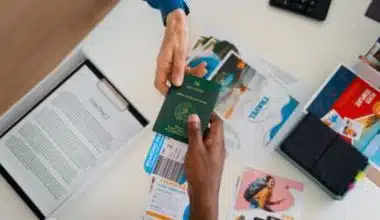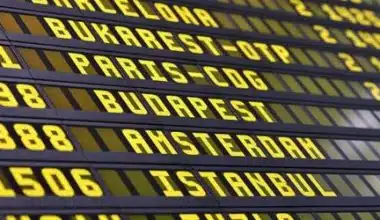You might not understand all of the language used in the customs and border protection industries. Both the well-known services, TSA PreCheck and Global Entry, can help you skip through airport security checkpoints. You may even be familiar with Mobile Passport or CLEAR, but are you familiar with a Redress Number? While a Redress Number won’t be required for the great majority of travelers, it could be required for a small number of people to lessen the stress of airport security.
In this article, let’s examine all you should know about this so you can determine whether it would be beneficial to you.
What Is A Redress Number?
The Department of Homeland Security (DHS) provides people who have trouble getting through security checks at transportation hubs like airports with a Redress Number, which is a special identification number. It is designed to expedite the border security process and prevent future false matches between individuals who have been misidentified as matching a watchlist in the past. A Redress Number is different from a Known Traveler Number (KTN), which is issued to individuals approved to receive TSA PreCheck expedited screening.
Benefits Of A Redress Number
A Redress Number provides several benefits to individuals who have experienced difficulties during screening at transportation hubs, such as airports. Here are some of the benefits of having a Redress Number
#1. Expedited Screening Process
With a Redress Number, individuals can potentially have an expedited screening process at airports. They may experience shorter wait times and undergo less intensive security procedures.
#2. Prevention of False Matches
A Redress Number helps prevent future false matches of individuals who have been misidentified as matching a watchlist in the past. This can help avoid unnecessary delays and inconveniences during the screening process.
#3. Improved Travel Experience
By having a Redress Number, individuals can expect a smoother and more efficient travel experience, as their previous issues or misidentifications can be addressed and resolved in advance.
#4. Redress Case Matching
The Redress Number allows the Transportation Security Administration’s (TSA) Secure Flight program to match travelers with the results of their redress case. This ensures that any previous concerns or misunderstandings are taken into account during the screening process.
#5. Clearance from Watchlist Errors
If an individual has been mistakenly identified as matching a watchlist in the past, a Redress Number can help clear their name and prevent future misunderstandings or delays during the screening process.
#6. Customer Service Support
Having a Redress Number provides individuals with access to dedicated customer service support. They can contact the Department of Homeland Security’s Traveler Redress Inquiry Program (TRIP) for assistance with any travel-related issues or concerns.
A Redress Number allows individuals to address and resolve any travel-related issues they may have encountered previously. It improves their overall travel experience and prevents recurring problems.
#8. Avoidance of Security Hassles
Attaching a Redress Number to air travel reservations can help individuals avoid unnecessary security hassles when flying or crossing U.S. borders. This can lead to smoother and more efficient travel experiences.
Global Entry Card Redress Number
A Global Entry Card Redress Number, also known as a Known Traveler Number (KTN), is a unique identification number assigned to individuals who have been approved for the Global Entry program but may have experienced issues or delays when traveling. When entering the United States or going abroad, this number is utilized to simplify and hasten the security screening procedure.
To obtain a KTN, you must apply and be approved for the Global Entry program, which involves a thorough background check and interview with U.S. Customs and Border Protection (CBP).
Benefits Associated With Having A Known Traveler Number
#1. Format
For TSA PreCheck members, the KTN is a 9-digit number that can be a combination of letters and numbers, mostly beginning with “TT” for those who enrolled through IDEMIA or “TE” for those who enrolled through Telos, both of which are official TSA PreCheck enrollment providers[1]. For members approved for Global Entry, NEXUS, or SENTRI, the KTN is the CBP PASS ID number, which is also a 9-digit number that usually begins with 10, 13, 14, 15, 16, 50, 70, 80, 95, 98, or 99.
#2. Efficient Travel Experience
With a Known Traveler Number, you can experience a more efficient and streamlined travel process. By bypassing the regular security lines and going through the expedited lanes, you can save time and avoid the hassle of removing your shoes and electronics.
#3. Access to Global Entry Benefits
Known Traveler Numbers through the Global Entry program offers expedited customs, immigration processing, automated kiosks, and TSA PreCheck eligibility for international travelers entering the US.
#4. Compatibility with Multiple Airlines
The Known Traveler Number can be added to your airline reservations, allowing you to enjoy the benefits of expedited screening consistently across multiple airlines and participating airports.
#5. Convenience for Frequent Travelers
For individuals who frequently travel by air, having a Known Traveler Number can greatly enhance the overall travel experience by saving time and minimizing the stress associated with security procedures. This is especially beneficial for business travelers or individuals who fly regularly.
#6. Family Members
Some trusted traveler programs allow you to include eligible family members, such as children under a certain age, in your application. Your family members can also receive their Known Traveler Numbers and enjoy the benefits of expedited screening when traveling together.
#7. Renewal and Expiration
Known Traveler Numbers have an expiration date that corresponds to the expiration date of your trusted traveler program membership. It’s vital to keep track of the expiration date and renew your membership on time to ensure uninterrupted access to the benefits of expedited screening.
#8. Multiple Programs
A Known Traveler Number can be utilized for TSA PreCheck as well as other trusted traveler programs like Global Entry, NEXUS, or SENTRI. When crossing international or land borders, this may offer significant advantages.
#9. Expedited Security Screening
A Known Traveler Number (KTN) allows expedited security screening at airports, including dedicated TSA PreCheck lanes, where passengers can keep shoes, belts, jackets, laptops, and liquids in their bags.
#10. No Card Access
A Trusted Traveler card, such as a Global Entry card, does not grant access to TSA PreCheck lanes. Travelers must add their KTN or CBP PASS ID to their airline reservations to ensure the TSA PreCheck indicator appears on their boarding pass.
Redress Number TSA
A Redress Number is a unique seven-digit identifier issued by the Transportation Security Administration’s (TSA) Secure Flight program to match travelers with the results of their redress case through the DHS TRIP program.
While a Redress Number can be beneficial for travelers who have experienced security issues in the past, there are some potential drawbacks to consider:
#1. Limited Use
A Redress Number is specific to the TSA’s Secure Flight program and does not apply to other trusted traveler programs like TSA PreCheck or Global Entry. Therefore, it may not provide the same level of expedited screening benefits as a Known Traveler Number (KTN).
#2. Application Process
Applying for a Redress Number requires submitting a request through the Department of Homeland Security Traveler Redress Inquiry Program (TRIP)[2]. This process can be time-consuming and may require providing detailed information about past security incidents[2].
#3. Not a Guarantee
While a Redress Number can help prevent future false matches and streamline the watchlist matching process, it does not guarantee that you will always receive expedited screening or avoid security issues. Travelers with a Redress Number may still be subject to random or additional screening measures.
#4. Confusion with KTN
Some travelers may confuse a Redress Number with a Known Traveler Number (KTN). These are separate identifiers with different purposes, and using the wrong number when making reservations or checking in for a flight can lead to confusion and potential delays at the airport.
#5. Limited Availability
Not all travelers may be eligible for a Redress Number, as it is specifically for individuals who have experienced difficulties during screening or believe they have been unfairly or incorrectly delayed, identified for additional screening, or denied boarding. If you have not encountered these issues in the past, you may not qualify for a Redress Number.
#6. Limited Application
The Redress Number is applicable only for issues related to air travel and security screenings within the United States. It does not address or resolve any concerns or complications that may arise during international travel or with other transportation modes, such as trains or buses.
#7. Limited Assistance for Pre-existing Conditions
If you have a pre-existing medical condition or disability that may impact the screening process, the Redress Number may not provide comprehensive assistance or accommodations. Additional steps or documentation may be required to ensure that your specific needs are addressed during the screening process.
#8 Limited Dispute Resolution
The Redress Number primarily focuses on addressing false identifications and security concerns during screenings. It may not be effective in resolving other issues such as customer service problems with airlines or grievances related to baggage handling or flight delays. For such issues, alternative channels or procedures may need to be pursued.
#9. Ineffectiveness for Frequent Travelers
If you frequently travel and consistently encounter issues with false identifications or security concerns, the Redress Number may not provide a permanent solution. It may address individual instances or occurrences, but it may not exempt you from future incidents or eliminate the need for additional screening measures.
#10. Restrictive Nature
The redress number is specific to the individual for whom it is issued. Nobody else may transfer or use it. This means that if you are traveling with family or a group, they would need to apply for their Redress Numbers if they have experienced similar issues.
Redress Number On Global Entry Card
The TSA issues the Redress Number as a separate identifier for falsely identified threats to prevent false matches with watchlists. It is not included in a Global Entry card, which provides expedited entry into the US. It is not printed on a Global Entry card, as it is a separate identifier from the PASSID number issued to Global Entry members.
Traveler Redress Inquiry Program (DHS TRIP) may include the following:
You may be eligible for a Redress Number if you have experienced problems such as being denied boarding, delayed during travel for additional security screening, or having trouble getting through checkpoints at U.S. borders.
#2. Repeatedly Referred For Additional Screening
If you are frequently referred for additional screening at airports, you may qualify for a Redress Number.
#3. Difficulty Printing Boarding Passes
If you have encountered difficulties in printing your boarding passes, it could make you eligible for a Redress Number.
#4. Denied Or Delayed Entry Or Exit At U.S. Border Checkpoints
If you have been denied or delayed entry into or exit from the U.S. at a border checkpoint, you may be eligible for a Redress Number.
Eligibility Criteria For Obtaining a Global Entry Card
#1. U.S. citizens and U.S. lawful Permanent Residents
U.S. citizens and U.S. lawful permanent residents are eligible to apply for Global Entry membership.
#2. Citizens of Certain Countries
Citizens of certain countries are also eligible for Global Entry membership. Specific eligibility requirements may vary depending on the country of citizenship. It is recommended to check the U.S. Customs and Border Protection (CBP) website or contact the CBP directly to determine the eligibility requirements for your country of citizenship.
#3. Age Requirement
If you are under the age of 18, you must have the consent of your parent or legal guardian to participate in the Global Entry program.
#4. Reasons for Ineligibility
Providing false or incomplete information on the application Conviction of any criminal offense or having pending criminal charges or outstanding warrants, including driving under the influence Found in violation of any customs, immigration, or agriculture regulations or laws.
Is The Redress Number The Same As The Known Traveler Number?
The Redress Number and Known Traveler Number are different and serve different purposes. A Redress Number is for individuals who have been falsely identified as security threats, while a Known Traveler Number is for individuals who have been approved for Trusted Traveler programs. They serve different purposes and are not the same.
How Do I Get My Redress Number?
To obtain a redress number, visit the DHS TRIP website, complete an online application, provide the necessary documentation, submit the application, wait for review, and receive the number if approved.
What Is The Other Name For The Redress Number?
The other name for a redress number is a redress control number.
How Long Does It Take To Get A Redress Number?
The processing time for obtaining a Redress Control Number can vary. The minimum length of the review process for a redress request is typically 30 business days. However, some sources mention that it could take up to 50 business days for approval.
How Do I Get a Known Traveler Number?
To obtain a Known Traveler Number (KTN), apply for a trusted traveler program like TSA PreCheck or Global Entry, complete the application process, undergo a background check, attend an interview if required, receive a KTN, which is the same as a Redress Control Number, and add it to your flight reservations for expedited screening.
Is The Known Traveler Number The Same As The Passport Number?
No, a Known Traveler Number (KTN) is not the same as the passport number. The KTN is a separate nine-digit code issued to individuals approved for TSA PreCheck or other trusted traveler programs. It is used to indicate eligibility for expedited screening. The passport number is a unique identification number assigned to an individual’s passport.
Conclusion
The Redress Number is intended to assist these people in resolving their travel-related issues and averting complications in the future. KTNs can be added to airline reservations, making them convenient for frequent travelers, family members, and those with multiple programs. They also allow expedited security screening at airports but require a KTN or CBP PASS ID for access to TSA PreCheck lanes. A redress number has some limitations, as outlined in the article. The TSA issues the Redress Number as a unique identification for wrongly detected threats to avoid erroneous matches with watchlists. Since it is a different identifier from the PASSID number given to Global Entry members, it is not printed on a Global Entry card.
- HOW TO FIND FLIGHT NUMBER: Detailed Guide
- WHAT IS A FLIGHT NUMBER? All You Need To Know
- DO YOU NEED A PASSPORT TO GO TO ARUBA? Aruba Travel Requirements
- BEST SOLO TRAVEL GROUPS IN 2023
- PLACES YOU CAN GO WITHOUT A PASSPORT IN 2023






